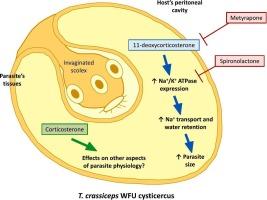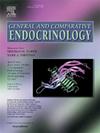矿化皮质激素对柞蚕WFU囊虫α-Na+/K+ atp酶表达及形态的影响
IF 1.7
3区 医学
Q3 ENDOCRINOLOGY & METABOLISM
引用次数: 0
摘要
矿化皮质激素是一种皮质类固醇激素,在脊椎动物中,通过调节Na+/K+ atp酶的表达和活性来调节细胞外液的体积和盐的平衡。Na+/K+ atp酶是一种产生和维持Na+和K+在质膜上梯度的酶。然而,矿物皮质激素在无脊椎动物中的作用尚未得到很好的研究。绦虫带绦虫囊虫(幼虫)体外合成皮质甾体11-脱氧皮质酮(DOC)和皮质酮。在此,我们检索了T. crassiceps的基因组和转录组,寻找α-Na+/K+ atp酶序列的存在。我们还研究了糖皮质激素对体外培养的天蚕囊尾蚴α-Na+/K+ atp酶表达和形态的影响。从先前感染的雌性小鼠的腹膜腔中获得囊虫,并在皮质酮、DOC、螺内酯(一种矿物皮质激素受体拮抗剂)或美替拉酮(一种皮质类固醇合成抑制剂)存在下以不同浓度和不同时间进行培养。Western blotting检测ATPase表达。通过基因组和转录组搜索,我们发现了两条高度保守的α-Na+/K+ atp酶序列。DOC可使α-Na+/K+ atp酶的表达呈浓度依赖性增加。与螺内酯孵育的寄生虫,而不是与metyrapone显著降低酶的表达。此外,DOC增加了寄生虫的大小,而螺内酯和metyrapone分别改变了寄生虫的形状和大小。这些结果提示矿物皮质激素在水盐调控中起一定作用。深入了解这些机制有助于改进囊虫病的治疗策略。本文章由计算机程序翻译,如有差异,请以英文原文为准。

Effects of mineralocorticoids on α-Na+/K+ ATPase expression and parasite morphology in T. crassiceps WFU cysticerci
Mineralocorticoids are corticosteroid hormones that, in vertebrates, regulate extracellular fluid volume and salt balance by modulating the expression and activity of Na+/K+ ATPase, the enzyme that generates and maintains Na+ and K+ gradients across plasma membranes. However, the function of mineralocorticoids in invertebrates has not been well studied. Cysticerci (larvae) of the parasite Taenia crassiceps WFU synthesize the corticosteroids 11-deoxycorticosterone (DOC) and corticosterone in vitro. Here, we searched the genome and transcriptome of T. crassiceps for the presence of α-Na+/K+ ATPase sequences. We also studied the effects of corticosteroids on α-Na+/K+ ATPase expression and on the morphology of T. crassiceps WFU cysticerci in vitro. Cysticerci were obtained from the peritoneal cavity of previously infected female mice and cultured in the presence of corticosterone, DOC, spironolactone (a mineralocorticoid receptor antagonist) or metyrapone (a corticosteroid synthesis inhibitor) at different concentrations and for different periods of time. ATPase expression was evaluated by Western blotting. Genome and transcriptome searches revealed two highly conserved α-Na+/K+ ATPase sequences in T. crassiceps WFU. DOC was found to increase α-Na+/K+ ATPase expression in a concentration-dependent manner. The incubation of parasites with spironolactone, but not with metyrapone, significantly decreased the expression of the enzyme. In addition, DOC increased parasite size, whereas spironolactone and metyrapone altered parasite shape and size, respectively. These results suggest a role for mineralocorticoids in salt–water regulation of T. crassiceps WFU. A deep understanding of these mechanisms could contribute to improving therapeutic strategies for cysticercosis.
求助全文
通过发布文献求助,成功后即可免费获取论文全文。
去求助
来源期刊

General and comparative endocrinology
医学-内分泌学与代谢
CiteScore
5.60
自引率
7.40%
发文量
120
审稿时长
2 months
期刊介绍:
General and Comparative Endocrinology publishes articles concerned with the many complexities of vertebrate and invertebrate endocrine systems at the sub-molecular, molecular, cellular and organismal levels of analysis.
 求助内容:
求助内容: 应助结果提醒方式:
应助结果提醒方式:


